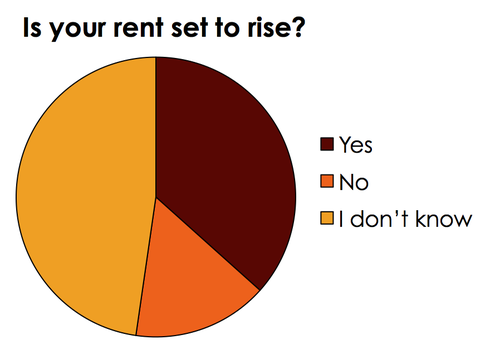
Rent is going up for many Qatar residents this year, and the housing allowances most employers provide are not keeping pace with the increases.
That’s one key finding of the Doha News inaugural housing survey, in which more than 1,000 respondents shared with us details about their living situation in Qatar.
The vast majority of those who answered the survey (98 percent) were not homeowners, a sign that much of Qatar’s population – in all income brackets – are closely watching the state of the rental market.
Increases afoot
More than a third of those polled said that their rent is set to increase this year, with monthly rates for some properties going up by as much as 20 percent, our statistics show.

Nearly half of those questioned weren’t sure what would happen, and only 15 percent said they definitely wouldn’t be seeing a rent increase this year.
The Qatar Economic Outlook 2012-2013 has forecast that rents are set to rise for some time yet, following a three-year lull.
Meanwhile, though 77 percent of respondents receive a housing allowance from their employer to cover the cost of renting a home on the private market, the gap between the allowance and the cost of rent is not insignificant.
For the mean average allowance of QR7,796, there is currently a QR1,132 difference between the average rent and the average housing allowance. But as rents go up, that difference is growing.
Mark Kettenis, senior associate at real estate company Coreo, told Doha News that his company has experienced this issue with many of its clients.
“Allowances are not keeping up with price of accommodation on the current market,” he told us. “If you have a family and you want decent accommodation, you’ll pay around QR14,000 a month now, minimum.”
Current occupancy levels in Doha hover at around 85 percent, although in areas like West Bay and the Pearl it is closer to 90 percent, a newly released report from property consultancy Colliers stated.
As the population continues to grow at around 4 percent a year from 2011 to 2017, the housing market will see a similar rise in demand, the report added.
“Tight” market
On the bright side, rents are not as high as they were during their peak five years ago. However, government protections during that time period are also no longer in effect.
In 2008, Qatar introduced a rental law that set a 10-percent limit on rent increases for tenants renewing their contracts, a move designed to restrict rapid inflation of rental prices.
However, this restriction ended in 2010.
“This means that landlords have the freedom to increase the rent after a contract ends without any caps,” Kettenis said.
The real estate expert described the current rental market as “very tight,” with many properties renting at “more than they are worth.” But he added that things should begin to improve by the end of the year:
“At the moment, we have a lot of demand, and not a lot of supply. But we think that by the end of the year, there will be more competition, with lots more projects coming on line, so there will be more choice.”
Our survey backs up Coreo’s market assessment. Some 36 percent of those questioned stated that their rent was due to rise, with the average stated increase being QR1,027 a month. That’s about an 11.5 percent jump on 2012 rents.
A wide range of rents
Rising rent aside, we’ve found a huge diversity in monthly rental prices across Qatar’s population.

While the mean average of rents was QR8,928 a month, 28 percent of respondents pay less than QR6,000, while 32 percent spend more than QR15,000. A very small minority – 3.6 percent – spend more than QR19,000 a month renting somewhere to live.
Other highlights of the survey include:
The expat population is increasingly in flux. A majority (45 percent) of respondents surveyed have only lived in their current home for a year. Some 25 percent had been in the same home for two years, 16 percent for three, and 2 percent for five. Notably, 6 percent lived maintained the same housing situation for more than six years, suggesting that those who stay in Qatar long-term are more likely to find a home they like, and stick to it.
Some 30 percent live in two-bedroom properties. The next largest group, 28 percent, live in three-bedroom homes, while 18 percent live in one-bedroom properties. Just 2 percent lived in homes with more than six bedrooms.
The majority (46 percent) of respondents lived in apartment blocks, while 29 percent resided in compound villas, 12 percent in stand alone villas, 10 percent in compound apartments and 2 percent in hotels and serviced apartments.
Some 63 percent of respondents live in households of two to four people. About 12 percent live alone, whilst 6 percent live in households of more than seven people.
Some 14 percent share accommodation with non-family members (other than domestic workers,) i.e friends and colleagues.
We’ll carry out the survey again next year to see how things have changed.
Source: Doha News
